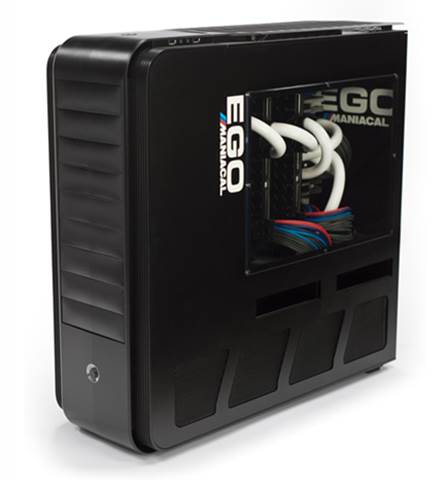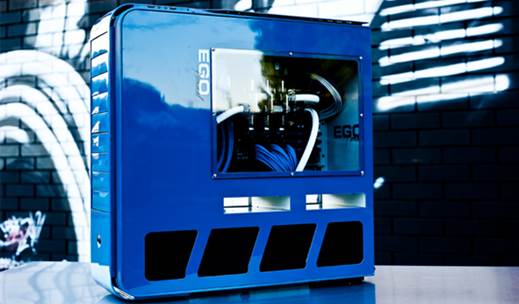A matte-black benchmark bruiser
Geekbox’s ego maniacal system pays homage
to Dream Machine but probably not the one you’re thinking of.
Sure, last year’s Dream Machine featured
the same Silverstone TJ11 chassis as the Geekbox Ego Maniacal, but we’re told
that actual inspiration for this custom built box was 2002’s Dream Machine,
which was painted to match a classic BMW 2002 Turbo. Except Geekbox has updated
its tribute to the car by nodding its head to the more current special edition
BMW M3 in “frozen black”

Geekbox
Ego Maniacal
The Ego might owe its inspiration to that
Dream Machine of old, but its internals are a closer match with 2012’s DM. Full
details of the Ego’s specs are down below, but the highlights include Intel’s
new king, the 3.5GHz Core i7-3970X, a pair of liquid-cooled GeForce GTX 690
cards, two 240GB Corsair Neutron GTX SSDs, 32GB of Corsair DDR3/1866, and a
1,200W Corsair AX1200i PSU. The most impressive part of the Ego may be its
liquid cooling, which uses both a quad-rad and dual-rad to keep the parts
cool-that includes the voltage regulation modules on the Asus Republic of Gamer
board.
That’s probably a good idea, too, because
the Ego pushes the new 3.5GHz Core i7-3970X to a very stable 4.8GHz. That’s
about 1GHz further than our zero-point’s overclocked six-core, and with its 25
percent higher clocks, the Ego offers that much more of a performance edge. In
fact, the six-core Ego gave our zero-point which is certainly no slouch in
specs – a pretty good pummeling in every single benchmark. What about something
a bit beefier, such as DM 2012?
Between the two, it was a classic battle of
cores vs. frequency, with DM2012 sporting eight cores at 3.1GHz vs. the Ego’s
six cores at 4.8GHz. in the apps that can’t exploit all the cores of the DM2012
(or even Ego, for that matter), clock speeds won out, with the Ego pulling up a
score 27 percent faster in Stitch.Efx 2.0 and 30 percent faster in ProShow
Producer 5.0. When you get into the heavily multithreaded tasks, however, the
cores-vs.-frequency argument gets interesting. The Ego was faster than the
DM2012 in Premiere Pro CS 5.0 by about 4 percent and about 1 percent faster in
the x264 HD 5.0 benchmark. That’s a victory for frequency, but at the same
time, we’re talking about a 1.7GHz difference between the six-core and
eight-core chips, so the core crowd can claim a moral victory. We also have to
acknowledge that the Ego set benchmark records in all six official benchmark
records in all six official benchmarks we run. Although not everything was by a
large margin, it’s still one hell of an accomplishment for one single system to
sweep all six.

The
Ego pushes the new 3.5GHz Core i7-3970X to a very stable 4.8GHz.
The real magic of the Ego is in the
phenomenal amount of detail paid to its construction. Geekbox says it spends no
less than 40 hours to build its high-end custom machines and its shows, from
the washers on the case door screws that prevent scratches to the paint, to the
custom-length cables that are each sleeved and heat-shrunk by hand (nary a zip
tie is present). There are other loving details about the case that we just
don’t have the space for here, but we must admit we were a bit let down by the
decals. Rather than covering them with a clear coat, Geekbox just stuck them
atop the matte-black paint job, which is decidedly less impressive you can feel
the decals’ edges when you slide your hand over them.
It’s also odd for the company not to
include mass storage, but Geekbox says that’s more of lifestyle statement. In
your garage, you’ll have your M3 for weekends and your minivan for weekdays, so
why clutter the M3 with baby seats? We understand that rational but we don’t buy
it, because while this machine is fast, it’s also expensive at $7,995. Yeah,
that’s a deal next to DM2012’s $11,055 but one HDD couldn’t hurt.

Geekbox
individually sizes and sleeves the cables for each PC it builds
Despite the interesting storage configuration
and heart-stopping price, we can’t argue with the raw performance and attention
to detail that might take custom rigs to the next level.
Our current desktop test bed consists of a Hexa-core
3.2GHz Core i7-3930K 3.8GHz, 8GB of Corsair DDR3/1600, on an Asus Sabertooth
X79 motherboard. We are running a GeForce GTX 690, an OCZ Vertex 3 SSD, and
64-bit Windows 7 Professional.
|
Info
·
Price: $7,99
·
Website: www.geekbox.com
Specifications
·
Processor: Intel Core i7-3970X 4.8Ghz
·
Mobo: Asus Rampage IV Extreme
·
RAM: 32GB DDR3/1866
·
Video Card: Two EVGA GeForce 690in SLI
·
Sound Card: Onboard
·
Storage: Two 240GB Corsair Neutron GTX SSDs in
RAID 0
·
Optical: None
·
Case/PSU: Silverstone TJ11/Corsair AX1200i
Verdict
·
Premiere Pro CS6 (sec): 1,612 (24%),
zero-point: 2,000
·
Stitch.Efx 2.0 (sec): 709 (19%), zero-point:
831
·
ProShow Producer 5.0 (sec): 1,194 (21%),
zero-point: 1,446
·
X264 HD 5.0 (fps): 25.6 (21%), zero-point:
21.1
·
Batman: Arkham City (fps): 134 (76%),
zero-point: 76
·
3DMark 11: 12,090 (107%), zero-point: 5,847
|